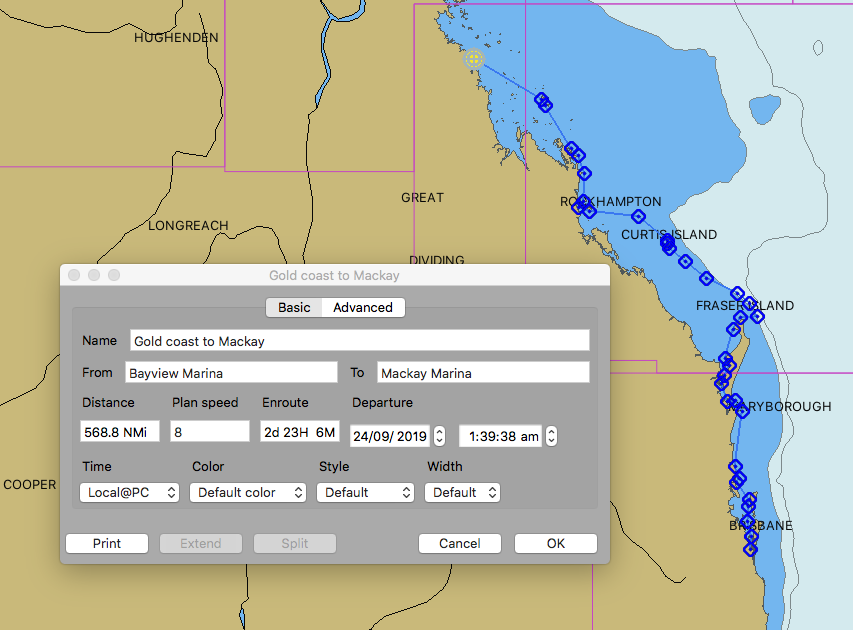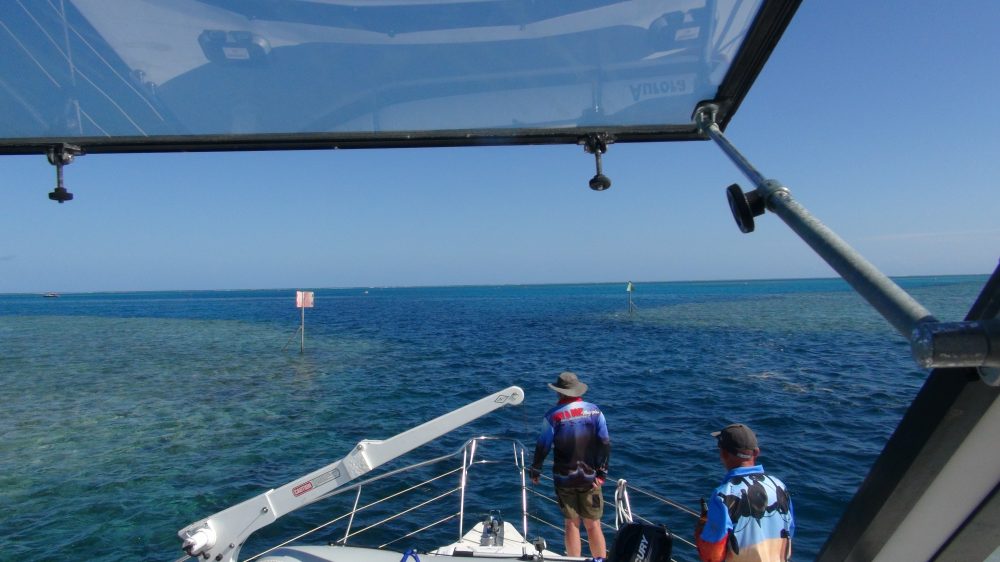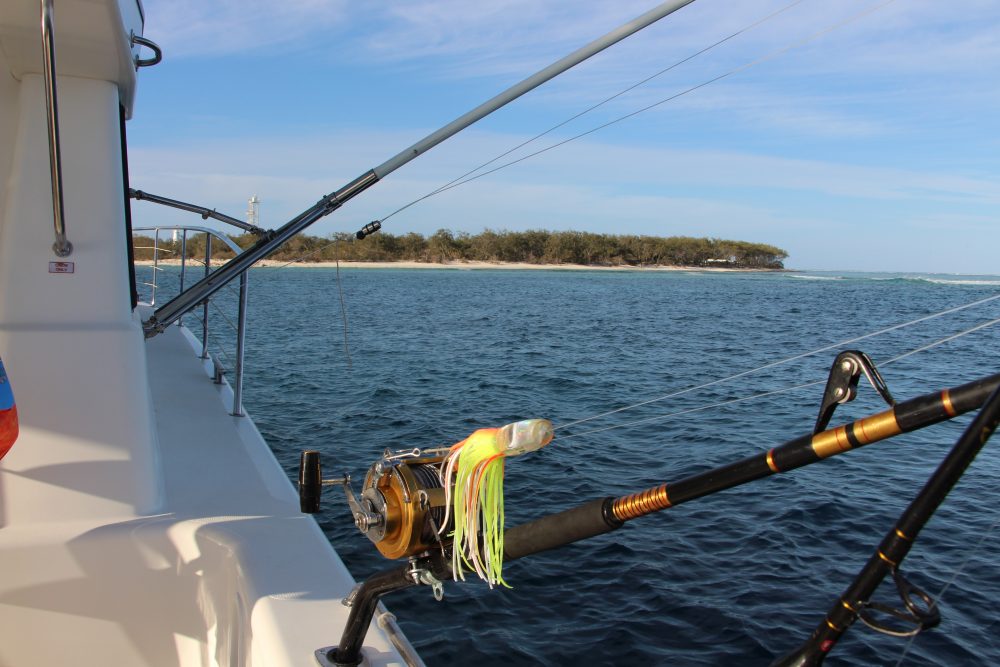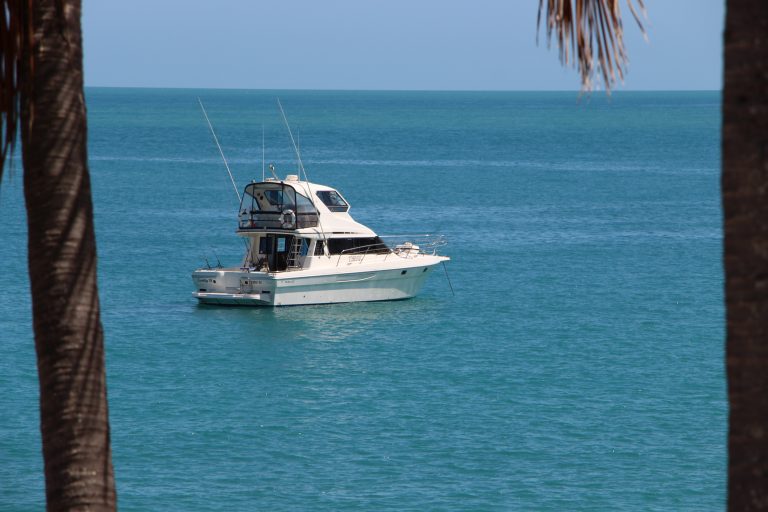So you have decided to buy a big boat: Part 2 – The delivery. By Graham Brake
The last vessel I delivered to Mackay was a 52 foot Sea Ranger. Onboard was the new owner and two of his mates, with the plan originally being to break up the trip with a couple of stops at scenic places like Lady Musgrave lagoon. Unfortunately cyclone Debbie put paid to this and the trip became a non-stop, 520 nautical mile run with the crew doing two hour watches as we surfed down large swells that built in size and strength the further north we came. Safely tied up in the Mackay marina on the Saturday before Debbie wreaked havoc over the Whitsundays, it was not your normal delivery. Luckily the moving of Motorvation was the polar opposite.
With safety the number one priority on any passage, prior to our departure there was quite a few things to do, purchases to be made and checks to be done. These included the purchase and installation of a new 10-man life raft and a new RHIB tender and four-stroke outboard. Safety gear, tooling and spares were checked and purchased as required and the anchor chain was run out on the dock and checked before being marked every ten meters to ensure correct scope was maintained when anchoring.
With a departure point of Bayview Marina on the Gold Coast, it is around 600 nautical miles to Mackay. At an average speed of 8 knots (the most efficient cruising speed) you are looking at approximately 75 hours of steaming. Our plan this time was to move her from the GC to Mooloolaba on a shake down run to test all the systems and ensure she was shipshape for the passage north. She would stay at the Sunshine Coast for three weeks until the school holidays when we then planned on a 10 day, leisurely passage to Mackay. This would enable Greg’s two young sons to join us and hopefully experience something new and exciting. This idea proved beneficial in more ways than one. Not only did we take 80nm out of the journey but we also uncovered a couple of issues that could have made the long journey much less enjoyable. The main issue concerned the Onan generator which would run fine before quickly tripping on over-temperature. With the salt water pump impellor ok, attention turned to the heat exchanger which upon disassembly proved to be a heavily corroded block of salt. Back in the marina, the exchanger was removed and delivered to a local marine shop who reconditioned it for us the same day. The other issue was not as important and concerned the aging electronics on the vessel. While the JRC depth sounder was working, the old Seiwa GPS took forever to update and the Raymarine radar refused to work at all. As we were not planning to travel at night and had my laptop for backup navigation, we could live with this for the delivery.

Delivery Chart.
Runaway bay to Mooloolaba
I must say I enjoyed this leg immensely as while I have sailed passed, I had never travelled inside Moreton and Stradbroke Islands before now. Anyone who looks at boats for sale would be familiar with the term “Moreton Bay Cruiser” which is normally associated with older, timber, trawler style vessels with many carrying the famous Norman Wright logo. After experiencing the many miles of shallow, protected waterways available throughout the area, I can now see the benefit of spending your days on this type of vessel around the myriad of islands and sand bars. Cruising past Russell Island was a real eye opener as I had no idea of the beauty of this location and can certainly see why it is becoming a retirement hotspot.
The other eyeopener for me was the huge numbers of large bream in all the waterways and especially the marinas. Sitting on the stern in the afternoon throwing small pieces of bread overboard soon had schools of these fish packed under us. As someone who could never understand the all-consuming attraction of bream and flathead fishing, my eyes are now well and truly opened. The bread also worked a treat when we spend a lazy afternoon and night tucked in tight behind the Tangalooma wrecks, only this time it was schools of gar that turned up. The temptation soon became too great so armed with smallest hooks we had onboard we ended up adding a couple of dozen mackerel baits to the freezer. From Tangalooma it was a nice morning run up to Mooloolaba where we gave the vessel a clean before the long drive back to Mackay the next day.

Fitztroy Logoon Entrance.
Mooloolaba to Fitzroy Island
Another long drive in a hire car loaded with gear had us back in Mooloolaba at the start of the school holidays. Joining Greg and the boys for the trip was brother in-law Eric and mate Damian and with the long standing nickname “Windy Eric” I was hoping this wasn’t an omen for what was to come. With the 2500 litre diesel tanks filled and enough food and liquid refreshments to last, we cast off the lines just after daylight and headed north with a plan to cross the Wide Bay bar and get through the shallowest part of the Great Sandy Strait (GSS) on the afternoon high tide. A good fifteen knots on the beam had the two boys a bit under the weather and we hoped a couple of days in the calm waters of the GSS would allow them to get their sea legs before the next leg of open ocean. Now Motorvation is a fishing boat. Outriggers, Reelax game-chair and Penn 80 wide outfits came with the boat so the temptation not to run a spread of lures was too great to ignore. With pushers on the Penns on outside lines and bibless and hardbody lures running down the centre on smaller outfits, we were on the approach to the bar when a centre line running a RapalaX Wrap Magnum 30 connected and started to lose line at a great rate of knots. Damian wrestled the rod from the holder and did a good job as a small black marlin danced behind the boat. Unfortunately, just as the crew were drawing straws to see who would don the gloves and do the hard work, the hook pulled as the fish jumped just as the leader came into view. Not a bad start for the first day.
A quick call to the local Coast Guard gave us the up-to-date coordinates for the bar (the WBB is notorious for the fact you have to do a 90 degree turn in the middle of the bar and the sand is continually moving) and we were then in the calm waters of the GSS. A long run following the beacons had us through the shallows and anchored at White Cliffs by late afternoon where a cold beer celebrated the end of a successful first day. Bait being smashed on the nearby wreck was too much to ignore so the rubber ducky was launched and Eric and Damian threw the tackle box at the area for naught. The next morning we ran up to Rooney Point where the plan was to chase the small black marlin that move into the area in numbers chasing the vast schools of bait. Unfortunately a local contact had informed us we were probably a month early and this proved correct. Not to worry, being anchored inside the point and listening to the whales pass close by throughout the night was an incredible experience.

It’s a tough life.
While local knowledge gave us the bad news in regards to the marlin bite inside Rooney’s, it also gave us the coordinates to safely cross the Breaksea Spit, so the next morning we gingerly made our way through the breaking shallows before emerging into the deep water available outside of Fraser Island. For a Mackay skipper where you have to travel 120nm to outside the reef to find water over 100 meters deep, it was remarkable to steam 10 miles and see the bottom drop to over 300 meters. The marlin lures were deployed and we motored north following the deep water shelf. Unfortunately, the small black hooked on the first day was to be the only bill fish sighted during the entire voyage. Also unfortunately, the auto pilot refused to engage, instead continually asking for an anti-theft code to be entered. Searching through all paperwork onboard, trying the usual suspects (1234, 0000 etc) and even opening the console hoping it was scribbled inside somewhere proved fruitless and we resigned ourselves to hand steering for the remaining 400nm.
After using a good part of the morning unsuccessfully chasing a large bill fish, we then covered the 35nm north to Lady Elliot Island, arriving mid-afternoon. While not the best anchorage, the weather was good enough for us to anchor off the south-western point for the night. The ducky was launched and a couple of the crew went ashore to chat with the people we could see on the beach, before they were politely advised they weren’t particularly welcome and advised to return to the boat.
The not-so-great anchorage lived up to expectations, so by daylight we were happy to pull the anchor and move three hours north to Lady Musgrave Island where the calm waters of the vast lagoon beckoned. Having tried to spend a day here on a previous delivery it was a relief to finally motor through the narrow entrance and join the other boats (about 20) inside this famous tourist attraction. Anchoring just outside the green zone allowed us to drop a line while Greg took the boys for a snorkel in the ducky. Eric and Damian added a few red throat emperor to the tally allowing us to have fresh fish for dinner while sipping white wine watching the sunset over Queensland. Honestly it doesn’t get much better.
A sleep-in followed by bacon and eggs was well received as we only had another short hop of 25nm to our next overnight stop in the lagoon at Fitzroy Island. This is another location I had never visited, but I had done my homework after Greg and I planned this delivery. Not only did I have the latest addition of the cruising yachties bible (Cruising the Coral Coast by Alan Lucas), I had also printed out some screen shots from Google Earth before leaving Mackay. This information had shown me the lagoon entrance at Fitzroy was much (much) narrower than Lady Musgrave and this was confirmed on arrival. So much narrower in fact that we decided to spend a few hours fishing to allow the incoming tide to do its thing before we entered the lagoon. Once again the red throat saved us as fishermen and after we watched a medium size trawler safely navigate the narrow entrance we decided it was time to find our anchorage for the night. After the rock and roll of Lady Elliot, the size and protection offered by these lagoons is mind blowing and I can see why they are a favourite for the cruising boat fraternity.

Lady Elliot island.
Fitzroy Island to Mackay
Our next stop was another island I had not previously visited. A 30nm run from Fitzroy takes you to North West Island with Heron island being almost exactly halfway between the two. While Heron is another resort where day trippers are discouraged, it was beautiful cruising through the channel and past the wreck of the HMAS Protector which was deliberately sunk after WW2 for use as a breakwater. Less than two hours later, we rounded the north western corner of North West Island and were astonished to see at least two dozen small boats on the beach and many people wondering around the exposed flats at low tide. A trip ashore in the dingy and a chat with the campers and island ranger told us how the island is a mecca for campers and fishermen, many of whom use the Curtis Ferry Service to bring over their boats and gear. While a fantastic spot for camping, the anchorage was far from perfect with another night of rock and roll experienced.
After North West we had scheduled a stop at Rosslyn Bay to top up the fuel and water and purchase fresh bread, fruit and cold meat. With a run of over 50nm we were looking at a pretty big day by the time we finished in port and then ran a little further north to North Keppel Island for our planned anchorage. After a disturbed sleep the previous night and a big day, it was nice sitting on the beach with a cold beer watching the sun set over the mainland before retiring to the vessel for a steak dinner washed down by good red wine – it doesn’t get much better!
On any delivery north, I always feel I am on the home stretch once I pass Island Head. I am not sure if this is because I am nearing waters where Volunteer Marine Rescue (VMR448) Mackay undertakes activations but in reality there is still over 100nm to travel. My usual overnight anchorage in this area is the beautiful Port Clinton but this time we have decided to travel a little further north and anchor in Island Head Creek. As we idled our way in
through the rocky outcrops at the mouth of the system we couldn’t help think of the two men who had recently died here when their large aluminium catamaran collided with an object in the area and was found drifting by another vessel. Without the official release of the result of the investigation we could only guess as to the circumstances surrounding the fatalities.

Middle Percy Lagoon.
Large bushfires burning in the surrounding hills made for smoky conditions but at least it helped keep the sandfly population in check. With the tide flooding into the system, we anchored on the edge of the channel where we could fish back into the adjacent rocky outcrop. Damian let a strip bait float down with the current and immediately hooked a quality grunter. “We should get a few more of these” were the famous last words as the javelin fish was the lone catch for the afternoon. The next morning we left the creek and instead of heading directly for the Percy Group we detoured slightly to enjoy the beauty of Pearl Bay. Lucas rates this highly as an anchorage but while it is very well protected and scenic you would have to monitor the depth carefully in any vessel with a bit of draft.
The next couple of days were spent exploring the Percy Group of islands where no visit is complete without visiting the famous Middle Island A Frame and all its “donations”. There is also the tidal lagoon, a short walk from the A Frame and a new one for me, the horizontal waterfall along the western shore of South Island. These form on the last of the ebb tide as water held back in couple of lagoons escapes over the rocky edges. A trip ashore to the sand hills in the southern bay of Middle Island was well received by the two boys who had a ball sliding down them.
With the spring tides now in full flow, any plans for more fishing were shelved and the decision made to make the 65nm to Mackay the last leg. The decision of waiting for the ebb tide before departure (the currents in this area can be extreme) didn’t really have the desired effect as we seemed to encounter most of the current on the beam for the majority of the leg. After ten days at sea, Motorvation was tied to her new berth in Mackay. The 600nm was done at an average of 8 knots with an average fuel burn of 27 litres per hour (total) – exceptional figures for a pair of 550hp 6V92 Detroit diesels.
Next time, we look at the vessel upgrades undertaken before the serious fishing commences.

South Percy Is horizontal waterfall.





